Analyzing Barriers and Communication Skills for Youth in the Workplace
VerifiedAdded on 2022/11/23
|6
|1744
|242
Report
AI Summary
This report examines the challenges and strategies for effective interpersonal communication when working with young people. It identifies key barriers such as lack of work experience, insufficient education, differing attitudes, and deficient career management skills. The report emphasizes the importance of essential communication skills, including active listening, confidence, open-mindedness, and respect. It highlights resources like emails, Slack applications, and social media for enhancing communication. The analysis provides valuable insights for management to foster positive and productive interactions with youth in the workplace, fostering better understanding and improved engagement. This report is a valuable resource for anyone seeking to improve their communication skills and effectiveness when working with young people.

Interpersonal communication skills
Paraphrase This Document
Need a fresh take? Get an instant paraphrase of this document with our AI Paraphraser
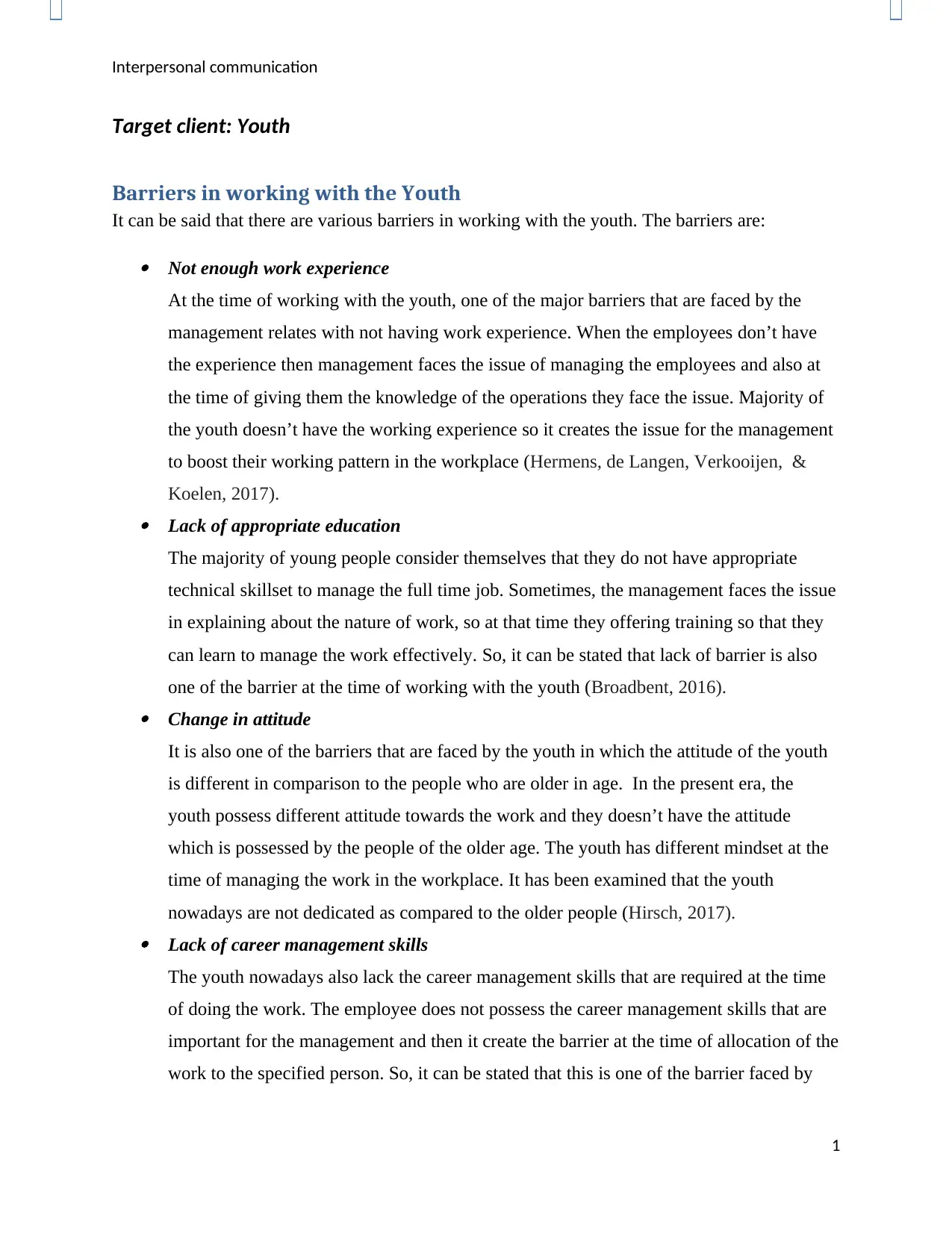
Interpersonal communication
Target client: Youth
Barriers in working with the Youth
It can be said that there are various barriers in working with the youth. The barriers are:
Not enough work experience
At the time of working with the youth, one of the major barriers that are faced by the
management relates with not having work experience. When the employees don’t have
the experience then management faces the issue of managing the employees and also at
the time of giving them the knowledge of the operations they face the issue. Majority of
the youth doesn’t have the working experience so it creates the issue for the management
to boost their working pattern in the workplace (Hermens, de Langen, Verkooijen, &
Koelen, 2017). Lack of appropriate education
The majority of young people consider themselves that they do not have appropriate
technical skillset to manage the full time job. Sometimes, the management faces the issue
in explaining about the nature of work, so at that time they offering training so that they
can learn to manage the work effectively. So, it can be stated that lack of barrier is also
one of the barrier at the time of working with the youth (Broadbent, 2016). Change in attitude
It is also one of the barriers that are faced by the youth in which the attitude of the youth
is different in comparison to the people who are older in age. In the present era, the
youth possess different attitude towards the work and they doesn’t have the attitude
which is possessed by the people of the older age. The youth has different mindset at the
time of managing the work in the workplace. It has been examined that the youth
nowadays are not dedicated as compared to the older people (Hirsch, 2017). Lack of career management skills
The youth nowadays also lack the career management skills that are required at the time
of doing the work. The employee does not possess the career management skills that are
important for the management and then it create the barrier at the time of allocation of the
work to the specified person. So, it can be stated that this is one of the barrier faced by
1
Target client: Youth
Barriers in working with the Youth
It can be said that there are various barriers in working with the youth. The barriers are:
Not enough work experience
At the time of working with the youth, one of the major barriers that are faced by the
management relates with not having work experience. When the employees don’t have
the experience then management faces the issue of managing the employees and also at
the time of giving them the knowledge of the operations they face the issue. Majority of
the youth doesn’t have the working experience so it creates the issue for the management
to boost their working pattern in the workplace (Hermens, de Langen, Verkooijen, &
Koelen, 2017). Lack of appropriate education
The majority of young people consider themselves that they do not have appropriate
technical skillset to manage the full time job. Sometimes, the management faces the issue
in explaining about the nature of work, so at that time they offering training so that they
can learn to manage the work effectively. So, it can be stated that lack of barrier is also
one of the barrier at the time of working with the youth (Broadbent, 2016). Change in attitude
It is also one of the barriers that are faced by the youth in which the attitude of the youth
is different in comparison to the people who are older in age. In the present era, the
youth possess different attitude towards the work and they doesn’t have the attitude
which is possessed by the people of the older age. The youth has different mindset at the
time of managing the work in the workplace. It has been examined that the youth
nowadays are not dedicated as compared to the older people (Hirsch, 2017). Lack of career management skills
The youth nowadays also lack the career management skills that are required at the time
of doing the work. The employee does not possess the career management skills that are
important for the management and then it create the barrier at the time of allocation of the
work to the specified person. So, it can be stated that this is one of the barrier faced by
1
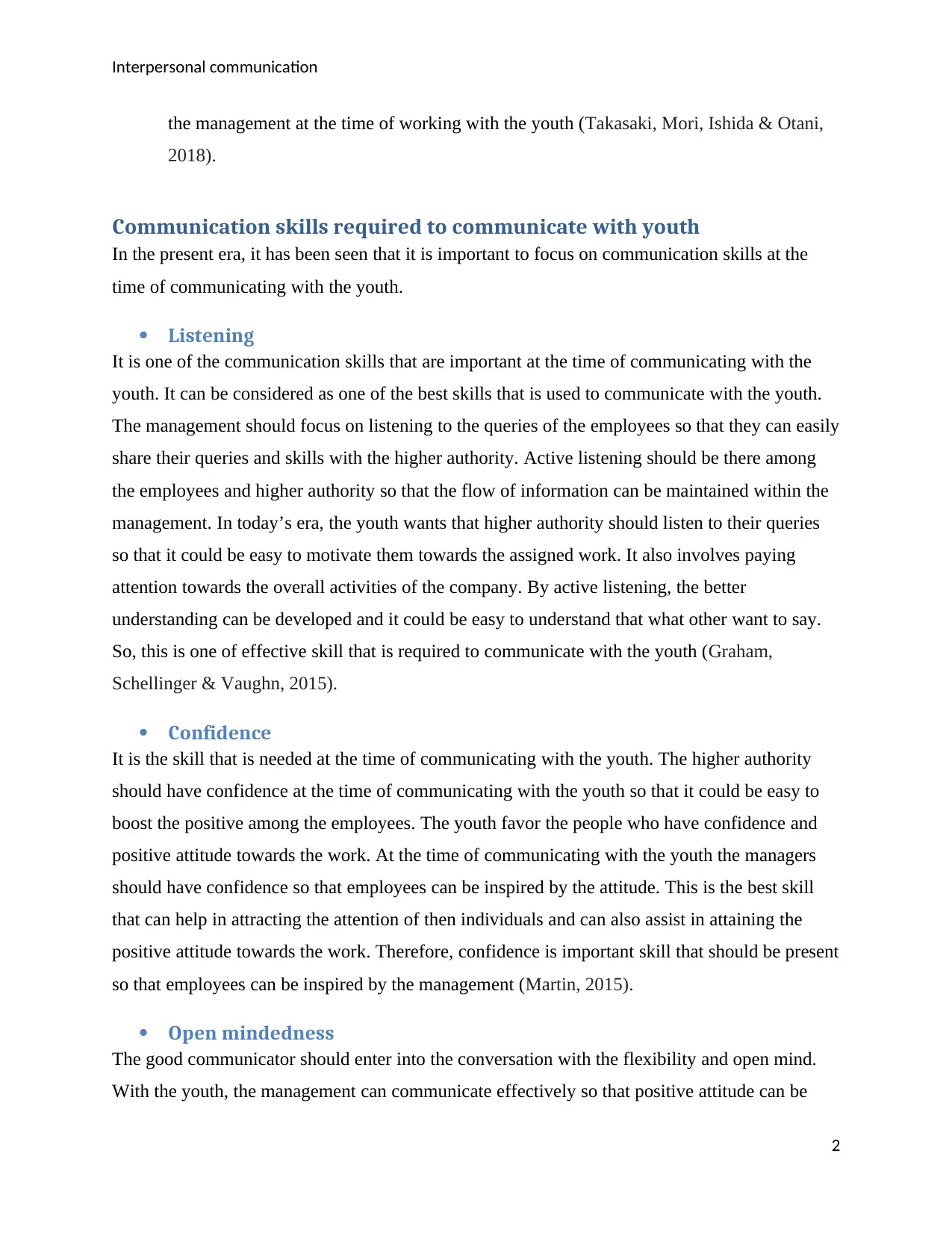
Interpersonal communication
the management at the time of working with the youth (Takasaki, Mori, Ishida & Otani,
2018).
Communication skills required to communicate with youth
In the present era, it has been seen that it is important to focus on communication skills at the
time of communicating with the youth.
Listening
It is one of the communication skills that are important at the time of communicating with the
youth. It can be considered as one of the best skills that is used to communicate with the youth.
The management should focus on listening to the queries of the employees so that they can easily
share their queries and skills with the higher authority. Active listening should be there among
the employees and higher authority so that the flow of information can be maintained within the
management. In today’s era, the youth wants that higher authority should listen to their queries
so that it could be easy to motivate them towards the assigned work. It also involves paying
attention towards the overall activities of the company. By active listening, the better
understanding can be developed and it could be easy to understand that what other want to say.
So, this is one of effective skill that is required to communicate with the youth (Graham,
Schellinger & Vaughn, 2015).
Confidence
It is the skill that is needed at the time of communicating with the youth. The higher authority
should have confidence at the time of communicating with the youth so that it could be easy to
boost the positive among the employees. The youth favor the people who have confidence and
positive attitude towards the work. At the time of communicating with the youth the managers
should have confidence so that employees can be inspired by the attitude. This is the best skill
that can help in attracting the attention of then individuals and can also assist in attaining the
positive attitude towards the work. Therefore, confidence is important skill that should be present
so that employees can be inspired by the management (Martin, 2015).
Open mindedness
The good communicator should enter into the conversation with the flexibility and open mind.
With the youth, the management can communicate effectively so that positive attitude can be
2
the management at the time of working with the youth (Takasaki, Mori, Ishida & Otani,
2018).
Communication skills required to communicate with youth
In the present era, it has been seen that it is important to focus on communication skills at the
time of communicating with the youth.
Listening
It is one of the communication skills that are important at the time of communicating with the
youth. It can be considered as one of the best skills that is used to communicate with the youth.
The management should focus on listening to the queries of the employees so that they can easily
share their queries and skills with the higher authority. Active listening should be there among
the employees and higher authority so that the flow of information can be maintained within the
management. In today’s era, the youth wants that higher authority should listen to their queries
so that it could be easy to motivate them towards the assigned work. It also involves paying
attention towards the overall activities of the company. By active listening, the better
understanding can be developed and it could be easy to understand that what other want to say.
So, this is one of effective skill that is required to communicate with the youth (Graham,
Schellinger & Vaughn, 2015).
Confidence
It is the skill that is needed at the time of communicating with the youth. The higher authority
should have confidence at the time of communicating with the youth so that it could be easy to
boost the positive among the employees. The youth favor the people who have confidence and
positive attitude towards the work. At the time of communicating with the youth the managers
should have confidence so that employees can be inspired by the attitude. This is the best skill
that can help in attracting the attention of then individuals and can also assist in attaining the
positive attitude towards the work. Therefore, confidence is important skill that should be present
so that employees can be inspired by the management (Martin, 2015).
Open mindedness
The good communicator should enter into the conversation with the flexibility and open mind.
With the youth, the management can communicate effectively so that positive attitude can be
2
⊘ This is a preview!⊘
Do you want full access?
Subscribe today to unlock all pages.

Trusted by 1+ million students worldwide
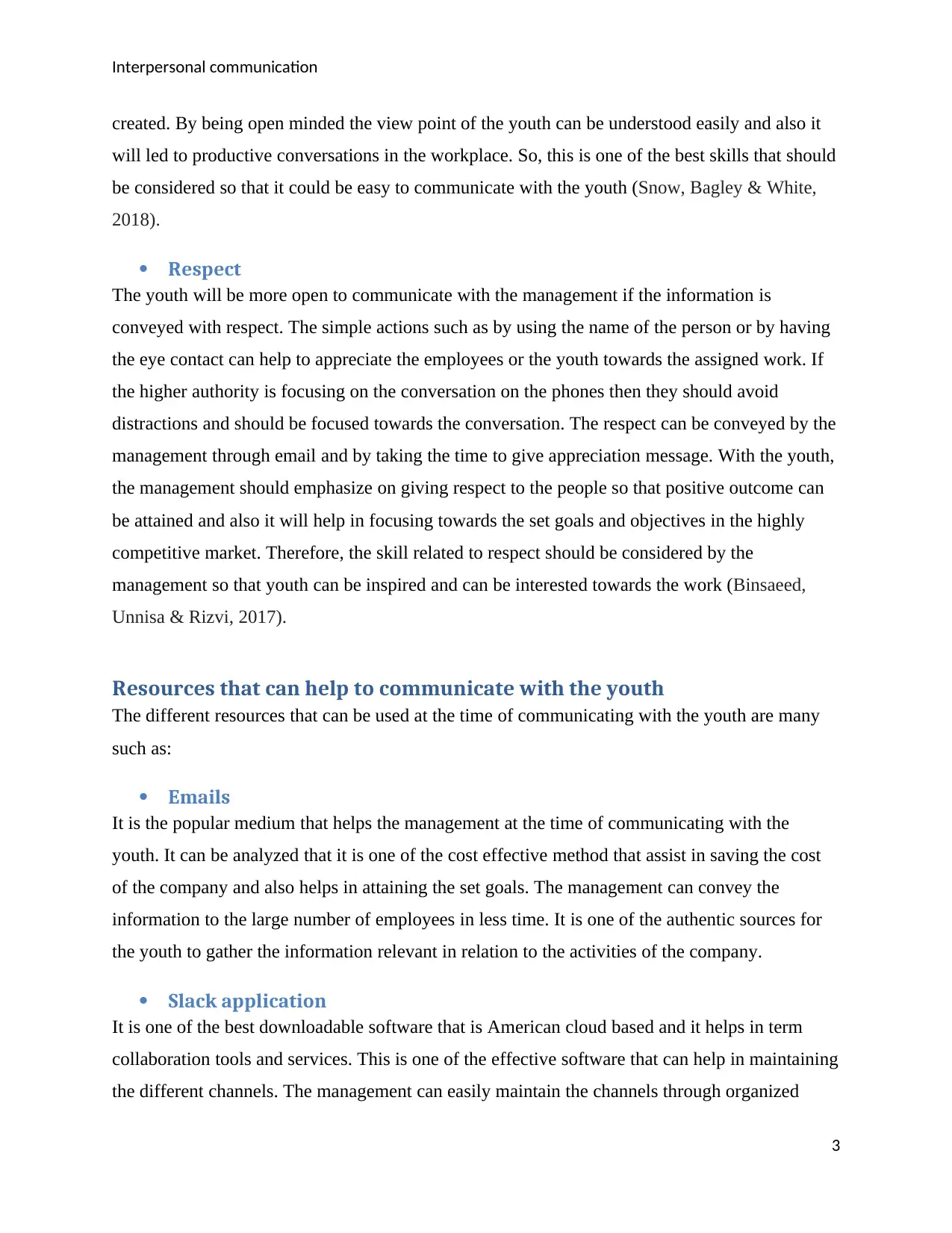
Interpersonal communication
created. By being open minded the view point of the youth can be understood easily and also it
will led to productive conversations in the workplace. So, this is one of the best skills that should
be considered so that it could be easy to communicate with the youth (Snow, Bagley & White,
2018).
Respect
The youth will be more open to communicate with the management if the information is
conveyed with respect. The simple actions such as by using the name of the person or by having
the eye contact can help to appreciate the employees or the youth towards the assigned work. If
the higher authority is focusing on the conversation on the phones then they should avoid
distractions and should be focused towards the conversation. The respect can be conveyed by the
management through email and by taking the time to give appreciation message. With the youth,
the management should emphasize on giving respect to the people so that positive outcome can
be attained and also it will help in focusing towards the set goals and objectives in the highly
competitive market. Therefore, the skill related to respect should be considered by the
management so that youth can be inspired and can be interested towards the work (Binsaeed,
Unnisa & Rizvi, 2017).
Resources that can help to communicate with the youth
The different resources that can be used at the time of communicating with the youth are many
such as:
Emails
It is the popular medium that helps the management at the time of communicating with the
youth. It can be analyzed that it is one of the cost effective method that assist in saving the cost
of the company and also helps in attaining the set goals. The management can convey the
information to the large number of employees in less time. It is one of the authentic sources for
the youth to gather the information relevant in relation to the activities of the company.
Slack application
It is one of the best downloadable software that is American cloud based and it helps in term
collaboration tools and services. This is one of the effective software that can help in maintaining
the different channels. The management can easily maintain the channels through organized
3
created. By being open minded the view point of the youth can be understood easily and also it
will led to productive conversations in the workplace. So, this is one of the best skills that should
be considered so that it could be easy to communicate with the youth (Snow, Bagley & White,
2018).
Respect
The youth will be more open to communicate with the management if the information is
conveyed with respect. The simple actions such as by using the name of the person or by having
the eye contact can help to appreciate the employees or the youth towards the assigned work. If
the higher authority is focusing on the conversation on the phones then they should avoid
distractions and should be focused towards the conversation. The respect can be conveyed by the
management through email and by taking the time to give appreciation message. With the youth,
the management should emphasize on giving respect to the people so that positive outcome can
be attained and also it will help in focusing towards the set goals and objectives in the highly
competitive market. Therefore, the skill related to respect should be considered by the
management so that youth can be inspired and can be interested towards the work (Binsaeed,
Unnisa & Rizvi, 2017).
Resources that can help to communicate with the youth
The different resources that can be used at the time of communicating with the youth are many
such as:
Emails
It is the popular medium that helps the management at the time of communicating with the
youth. It can be analyzed that it is one of the cost effective method that assist in saving the cost
of the company and also helps in attaining the set goals. The management can convey the
information to the large number of employees in less time. It is one of the authentic sources for
the youth to gather the information relevant in relation to the activities of the company.
Slack application
It is one of the best downloadable software that is American cloud based and it helps in term
collaboration tools and services. This is one of the effective software that can help in maintaining
the different channels. The management can easily maintain the channels through organized
3
Paraphrase This Document
Need a fresh take? Get an instant paraphrase of this document with our AI Paraphraser
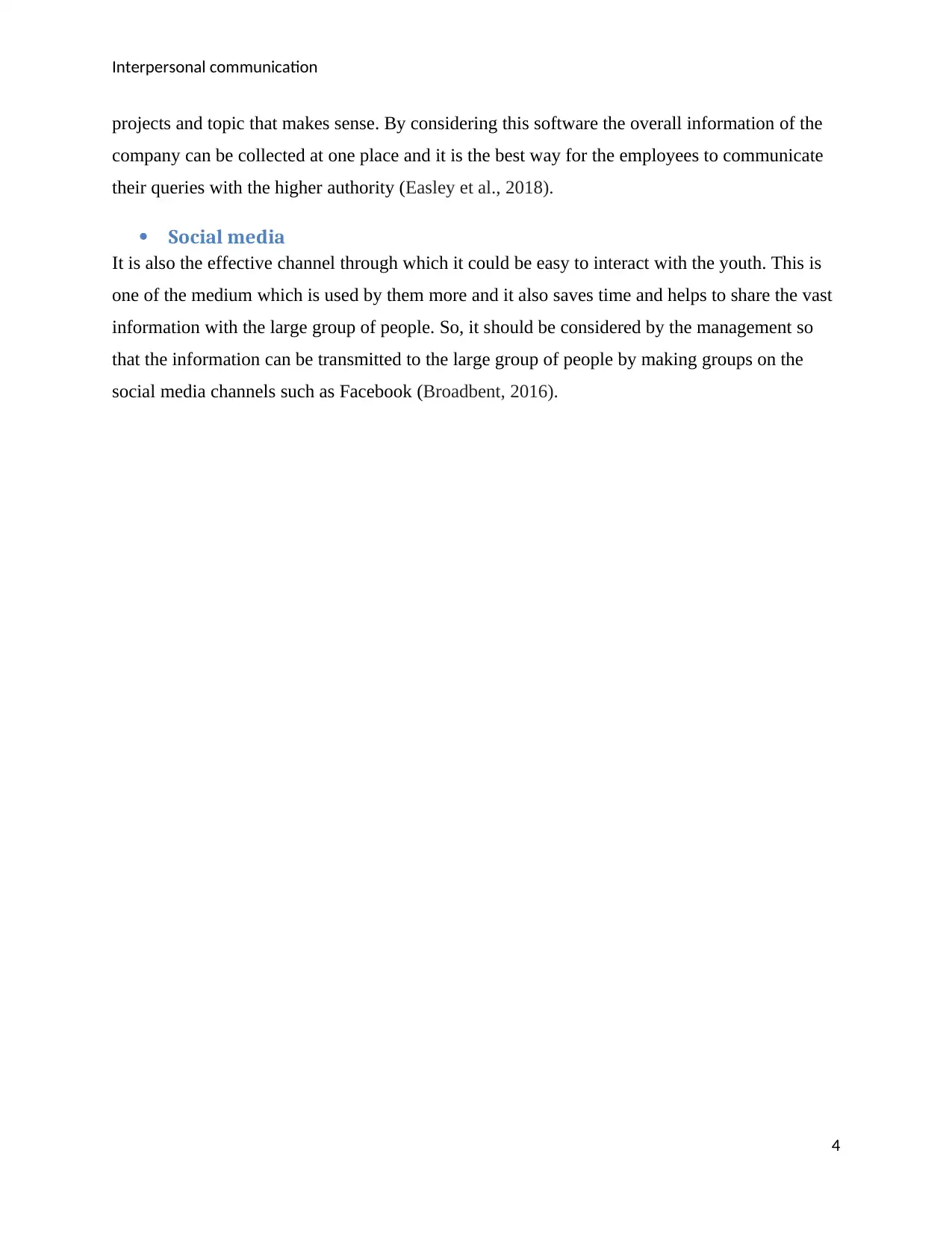
Interpersonal communication
projects and topic that makes sense. By considering this software the overall information of the
company can be collected at one place and it is the best way for the employees to communicate
their queries with the higher authority (Easley et al., 2018).
Social media
It is also the effective channel through which it could be easy to interact with the youth. This is
one of the medium which is used by them more and it also saves time and helps to share the vast
information with the large group of people. So, it should be considered by the management so
that the information can be transmitted to the large group of people by making groups on the
social media channels such as Facebook (Broadbent, 2016).
4
projects and topic that makes sense. By considering this software the overall information of the
company can be collected at one place and it is the best way for the employees to communicate
their queries with the higher authority (Easley et al., 2018).
Social media
It is also the effective channel through which it could be easy to interact with the youth. This is
one of the medium which is used by them more and it also saves time and helps to share the vast
information with the large group of people. So, it should be considered by the management so
that the information can be transmitted to the large group of people by making groups on the
social media channels such as Facebook (Broadbent, 2016).
4
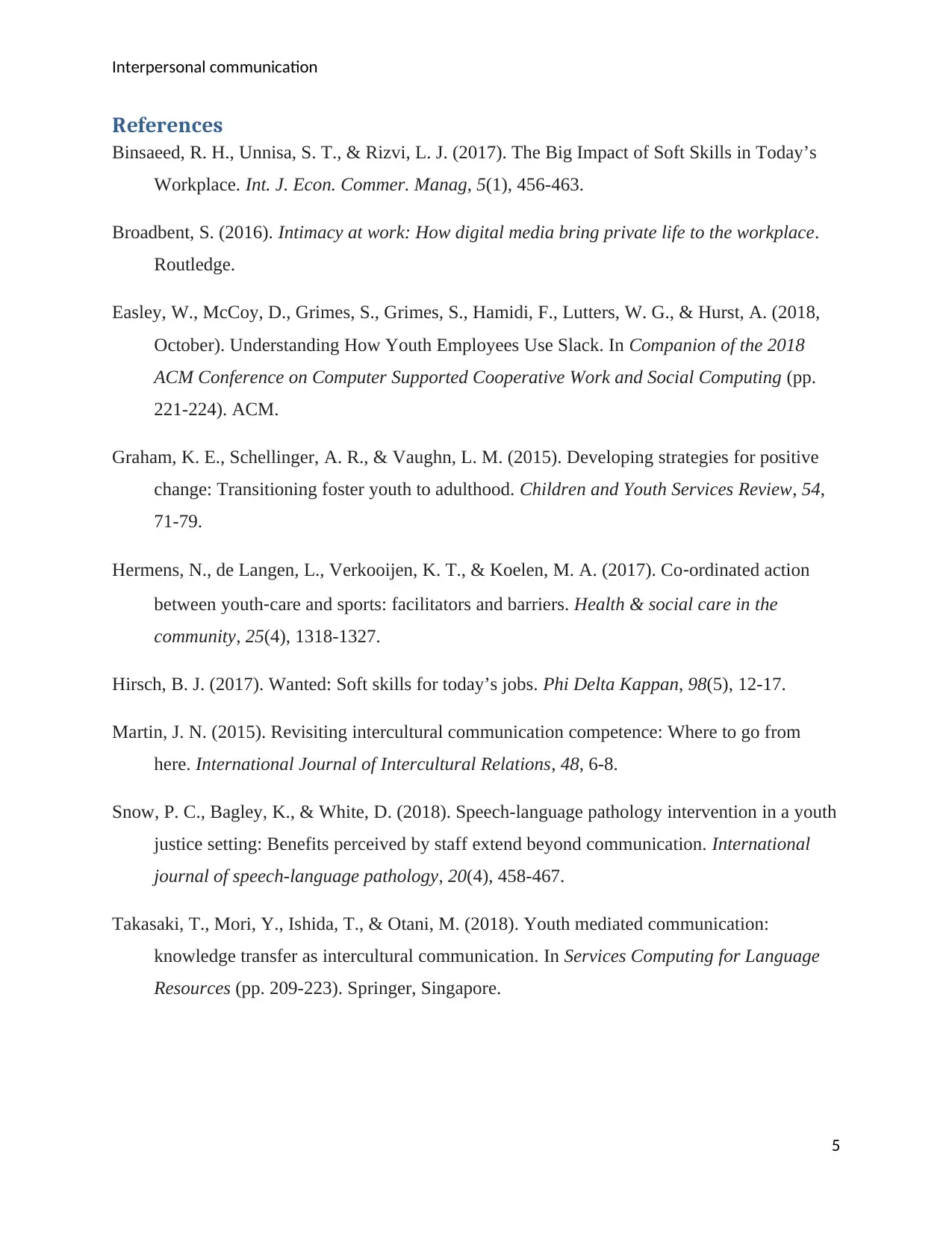
Interpersonal communication
References
Binsaeed, R. H., Unnisa, S. T., & Rizvi, L. J. (2017). The Big Impact of Soft Skills in Today’s
Workplace. Int. J. Econ. Commer. Manag, 5(1), 456-463.
Broadbent, S. (2016). Intimacy at work: How digital media bring private life to the workplace.
Routledge.
Easley, W., McCoy, D., Grimes, S., Grimes, S., Hamidi, F., Lutters, W. G., & Hurst, A. (2018,
October). Understanding How Youth Employees Use Slack. In Companion of the 2018
ACM Conference on Computer Supported Cooperative Work and Social Computing (pp.
221-224). ACM.
Graham, K. E., Schellinger, A. R., & Vaughn, L. M. (2015). Developing strategies for positive
change: Transitioning foster youth to adulthood. Children and Youth Services Review, 54,
71-79.
Hermens, N., de Langen, L., Verkooijen, K. T., & Koelen, M. A. (2017). Co‐ordinated action
between youth‐care and sports: facilitators and barriers. Health & social care in the
community, 25(4), 1318-1327.
Hirsch, B. J. (2017). Wanted: Soft skills for today’s jobs. Phi Delta Kappan, 98(5), 12-17.
Martin, J. N. (2015). Revisiting intercultural communication competence: Where to go from
here. International Journal of Intercultural Relations, 48, 6-8.
Snow, P. C., Bagley, K., & White, D. (2018). Speech-language pathology intervention in a youth
justice setting: Benefits perceived by staff extend beyond communication. International
journal of speech-language pathology, 20(4), 458-467.
Takasaki, T., Mori, Y., Ishida, T., & Otani, M. (2018). Youth mediated communication:
knowledge transfer as intercultural communication. In Services Computing for Language
Resources (pp. 209-223). Springer, Singapore.
5
References
Binsaeed, R. H., Unnisa, S. T., & Rizvi, L. J. (2017). The Big Impact of Soft Skills in Today’s
Workplace. Int. J. Econ. Commer. Manag, 5(1), 456-463.
Broadbent, S. (2016). Intimacy at work: How digital media bring private life to the workplace.
Routledge.
Easley, W., McCoy, D., Grimes, S., Grimes, S., Hamidi, F., Lutters, W. G., & Hurst, A. (2018,
October). Understanding How Youth Employees Use Slack. In Companion of the 2018
ACM Conference on Computer Supported Cooperative Work and Social Computing (pp.
221-224). ACM.
Graham, K. E., Schellinger, A. R., & Vaughn, L. M. (2015). Developing strategies for positive
change: Transitioning foster youth to adulthood. Children and Youth Services Review, 54,
71-79.
Hermens, N., de Langen, L., Verkooijen, K. T., & Koelen, M. A. (2017). Co‐ordinated action
between youth‐care and sports: facilitators and barriers. Health & social care in the
community, 25(4), 1318-1327.
Hirsch, B. J. (2017). Wanted: Soft skills for today’s jobs. Phi Delta Kappan, 98(5), 12-17.
Martin, J. N. (2015). Revisiting intercultural communication competence: Where to go from
here. International Journal of Intercultural Relations, 48, 6-8.
Snow, P. C., Bagley, K., & White, D. (2018). Speech-language pathology intervention in a youth
justice setting: Benefits perceived by staff extend beyond communication. International
journal of speech-language pathology, 20(4), 458-467.
Takasaki, T., Mori, Y., Ishida, T., & Otani, M. (2018). Youth mediated communication:
knowledge transfer as intercultural communication. In Services Computing for Language
Resources (pp. 209-223). Springer, Singapore.
5
⊘ This is a preview!⊘
Do you want full access?
Subscribe today to unlock all pages.

Trusted by 1+ million students worldwide
1 out of 6
Related Documents
Your All-in-One AI-Powered Toolkit for Academic Success.
+13062052269
info@desklib.com
Available 24*7 on WhatsApp / Email
![[object Object]](/_next/static/media/star-bottom.7253800d.svg)
Unlock your academic potential
Copyright © 2020–2025 A2Z Services. All Rights Reserved. Developed and managed by ZUCOL.



